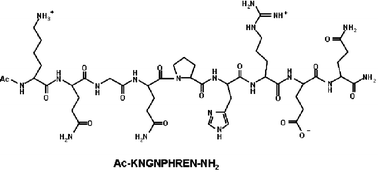Angiogenin is one of the more potent angiogenic factors known, whose activity may be affected by the presence of copper ions. Copper(II) complexes with the peptides encompassing the putative endothelial cell binding domain of angiogenin, Ac-KNGNPHREN-NH2 and Ac-PHREN-NH2, have been characterized by potentiometric, UV-vis, CD and EPR spectroscopic methods. The coordination features of all the copper complex species derived by both peptides are practically the same, as predictable because of the presence of a proline residue within their aminoacidic sequence. In particular, Ac-PHREN-NH2 is really the aminoacidic sequence involved in the binding to copper(II). Thermodynamic and spectroscopic evidence are given that side chain oxygen donor atom of glutamyl residue is involved in the copper binding up to physiological pH. EPR parameters suggest that the carboxylate group is still involved also in the predominant species [Cu(L)H−2], the metal coordination environment being probably formed by NIm, 2N−, H2O in equatorial plane and an oxygen atom from COO− in apical position, or vice versa, with the carboxylate oxygen atom in the copper coordination plane and the water molecule confined to one of the apical positions. Moreover, the comparison with the thermodynamic and spectroscopic results in the case of the copper(II) complex species formed by the single point mutated peptide, Ac-PHRQN-NH2, provides further evidence of the presence of carboxylate oxygen atom in the copper coordination sphere.
